All track, no train. What will it take to get Tri-Rail to north county?
Posted by Joel Engelhardt on February 3, 2021 · 2 Comments
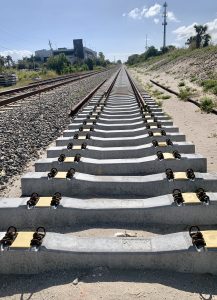
A second set of tracks lies next to the existing Florida East Coast Railway tracks on Jan. 29 just south of Richard Road and west of Alternate A1A in Palm Beach Gardens. The Brightline passenger rail service is double-tracking the FEC line from West Palm Beach to Cocoa as part of its $2.7 billion plan to provide Miami-to-Orlando service in 2023. (Joel Engelhardt photo)
For the first time since its inception in 1989, Tri-Rail is physically able to run its trains from Miami all the way through Palm Beach Gardens to Jupiter.
Officials have been looking forward to this moment for decades to make good on a promise of delivering commuter rail to north county.
But there’s still a big hurdle in making a short-stop coastal commuter rail service real: Money. Lots of it. In fact, the rail line is still hundreds of millions of dollars away from actually delivering.
That hasn’t stopped transportation advocates from pushing the link. They’re encouraged by two recent developments: the double-tracking happening now on the easternmost Florida East Coast Railway tracks, courtesy of the long-haul passenger service Brightline, and the recent completion of a $4.2 million crossover in West Palm Beach to let Tri-Rail trains switch seamlessly from the CSX rail line to the FEC.
The FEC is the easternmost line that, unlike CSX, rolls right through north county cities and towns.
Two hurdles could derail this north county expansion: The rail service doesn’t have permission from Brightline to operate on the FEC tracks and Palm Beach County has not begun negotiating a price.
And, more critically, local officials haven’t figured out how to pay for the rest of the project, particularly new stations and new sidings at a price of more than $100 million.
Oh, and the cost to actually run the trains could be as high as $19 million a year, a figure fares alone will not cover.
Until these issues are resolved, the hop-on-board support needed to spend taxpayer money in such a big way can’t leave the station.
A steering committee assigned to the task last met in February 2018 before acknowledging the difficulty of overcoming those unresolved issues and shutting down. The panel’s final instruction to staff went nowhere: No north county cities stepped up to agree in writing to offer “local funding options,” although Palm Beach Gardens has approved a mobility fee.
But the issue popped up again at a meeting Jan. 21, when the chief of the Florida Department of Transportation in Fort Lauderdale, Gerry O’Reilly, responded to a question from Palm Beach County Commissioner Robert Weinroth. He said preliminary planning for the Tri-Rail Coastal Link is on hold because local officials haven’t lined up ways to pay for the project.
“This project has advanced through all the stages it needs to. Now it needs entities to say they would pay the costs of the train. Dade and Broward have done that,” O’Reilly told Weinroth at a meeting of the county’s Transportation Planning Agency. “You need to decide if someone in Palm Beach County is going to pay for the operating fee.”
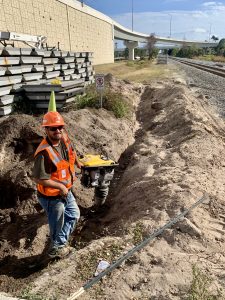
A worker digs a trench Jan. 31 to prepare for the upcoming double-tracking of the Florida East Coast Railway line at Kyoto Gardens Drive in Palm Beach Gardens, just west of the Gardens Mall. (Joel Engelhardt photo)
Brightline ready to deal
If O’Reilly and other advocates had their way, Palm Beach County officials would step up as their southern counterparts did. Voters in both Broward and Miami-Dade have approved sales tax hikes to pay for transportation projects.
Some of that money could cover the huge costs of offering commuter train service on the FEC line.
Such a tax in Palm Beach County likely would have to get voter approval and await the expiration around 2026 of the county’s current sales tax “surcharge,” an extra penny on every dollar, which raises the county’s sales tax to 7 percent.
Costs could better come into focus as Brightline for the first time has expressed interest in sharing its coastal tracks with a short-haul commuter line.
For a price.
In November, Miami-Dade County agreed to negotiate a contract paying Brightline up to $50 million and $12 million a year for 30 years for the right to run commuter trains on the FEC corridor. A final agreement remains to be negotiated.
Broward is next. But talks about access between Brightline, which suspended its nascent Miami-to-West Palm Beach service after COVID struck, and Palm Beach County haven’t begun.
While Broward, Dade and the southern half of Palm Beach County already have Tri-Rail, its tracks are west of most downtowns. The state paid $264 million in 1988 to buy the tracks, which also carry Amtrak and freight trains, and later spent $300 million over 10 years to double-track the 71-mile corridor.
But it’s just not enough to serve the core population living closer to the coast.
While Tri-Rail is on pace to record its 100-millionth rider in August, it envisions luring more passengers if trains stop in the center of a downtown, a high-stakes move to a different rail corridor talked about since the early 1990s.
“The last mile is often a challenge for commuter rail,” said Steven Abrams, a former Palm Beach County commissioner and Boca mayor who runs Tri-Rail’s South Florida Regional Transportation Authority. “The last mile is less of a challenge when where you’re going is within walking distance of the station.”
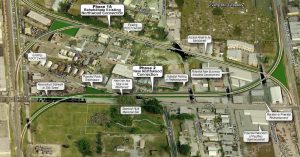
Map provided by Tri-Rail shows the connections both for northbound and southbound trains at 25th Street in West Palm Beach. Work on the $4.2 million project was completed in late 2019, providing an historic opportunity to run Tri-Rail trains into Riviera Beach, Palm Beach Gardens and Jupiter.
25th Street connector
There are two ways to get commuter rail to north county.
Trains could run from Miami north on the FEC line. Or passenger cars could switch from Tri-Rail’s CSX tracks to Brightline’s FEC tracks at 25th Street in West Palm Beach.
The link is between Tri-Rail’s two most northern stations, the downtown West Palm station on Tamarind Avenue and the Mangonia Park station, next to the vacant jai-alai fronton on 45th Street.
After Mangonia, the CSX line veers to the west toward Indiantown in Martin County. The FEC, built by Henry Flagler more than 100 years ago, continues up the Florida coast to Jacksonville.
The 25th Street connection became reality in 2019 after a federal grant paid for Tri-Rail and FDOT to build the half-mile link between Australian Avenue and U.S. 1.
At one time, officials considered — and rejected — building the connection in the heart of downtown West Palm Beach.
The only other FEC/CSX connection is at 79th Street in Hialeah. A third connection is planned for Pompano Beach.

The Florida East Coast Railway tracks cross Kyoto Gardens Drive just west of the Gardens Mall in Palm Beach Gardens on Jan. 31. (Joel Engelhardt photo)
All on board for $100 million?
Switching Tri-Rail trains from the CSX line to the FEC at 25th Street could bring commuter rail into north county for the first time since passenger service stopped in the 1960s.
But at what cost?
The steering committee, which brought together regional transportation planners and elected officials, spelled out the potential costs in 2018, based on 2014 calculations adjusted for inflation.
They considered five north county stations: 45th Street in West Palm Beach, 13th Street in Riviera Beach, Park Avenue in Lake Park, PGA Boulevard in Palm Beach Gardens and Toney Penna Drive in Jupiter.
They anticipated spending nearly $13 million to buy the land for stations and parking and $35 million to build the stations.
Another $59 million would go toward installing extra tracks around the stations to allow Brightline and freight traffic to pass as passengers got off and on the trains.
That’s $107 million just to get rolling — without a payment to Brightline for the rail line.
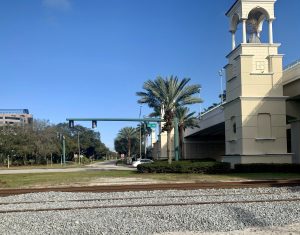
Rails line up next to the Florida East Coast Railway tracks just north of PGA Boulevard (elevated at right) along Alternate A1A in Palm Beach Gardens. (Joel Engelhardt photo)
While officials put the cost of a locomotive and three train cars at $17 million, they figured Tri-Rail would use its existing trains to spare that expense.
Running 50 trains every weekday, presumably under Tri-Rail, will cost another $12 million to $19 million a year.
Subsidies are required because riders aren’t going to immediately flock to the trains, meaning fares won’t cover costs.
While most of the money likely would come from federal or state sources, powered by taxpayers, the local match could be as much as 40 percent, officials said.
Sales and property taxes and utility fees could be tapped, as could the property tax on rising land values due to denser development near stations.
No decisions were reached and no city has volunteered to commit.
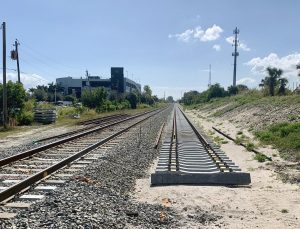
A second set of tracks lies next to the existing FEC tracks on Jan. 29 just south of Richard Road and west of Alternate A1A in Palm Beach Gardens. (Joel Engelhardt photo)
Why bother?
Local officials have to contend with a natural skepticism toward paying for a service that may never pay for itself. Heeding advice that trains are needed now, to prepare for inevitable gridlock on the regional road network, is a hard sell.
As Abrams pointed out, “Four hundred cars equal eight buses equal one train.”
Many residents oppose commuter service because, with up to 50 trains a day going back and forth, it will mean more frequent waits on east-west roads for rail gates to lift. They also object to the blare of train horns, although steps are promised to create “quiet zones,” as achieved with Brightline from Boca to West Palm.
The consequences, as Brightline encountered, could well be a rising number of people stepping in front of quiet, fast-moving trains.
And, has been the case for decades, many residents balk at paying hundreds of millions of dollars to subsidize transportation for thousands.
Supporters say the government already pays billions to subsidize roads that will be so overwhelmed by traffic that investing in trains now will appear visionary 50 years out.
Reducing reliance on cars is a huge help for the environment, they say, and opening up land near tracks to take advantage of rail is big business. A 2013 study for Tri-Rail said the Coastal Link could generate $1.4 billion in new development, including 5,500 residential units and 8 million square feet of commercial.
Brightline construction half-done
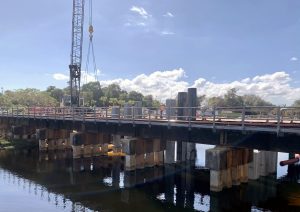
The railroad bridge over the Earman River in Palm Beach Gardens, also called the C-17 Canal, is one of 29 bridges being rebuilt by the Brightline passenger rail service as it adds a second set of tracks along the FEC Railway between West Palm Beach and Cocoa. The bridge, pictured here on Jan. 29, is just west of Alternate A1A and north of Northlake Boulevard. (Joel Engelhardt photo)
Meanwhile, Brightline, a privately owned company, is halfway done with its $2.7 billion expansion from West Palm Beach to Orlando, spokeswoman Katie Mitner told the Treasure Coast Regional Planning Council on Jan. 15. Completion is expected in 2023.
While Brightline began operating passenger trains in January 2018 between West Palm Beach and Miami, it suspended service in March 2020 because of the COVID-19 outbreak.
While often referred to as high-speed rail, Brightline trains can reach a top speed of 79 mph on the Miami-to-West-Palm section and up to 110 mph farther north. High-speed rail is generally considered to start at 160 mph.
After searing criticism over Brightline’s decision to build coastal stations only in Miami, Fort Lauderdale and West Palm Beach, the rail service has committed to adding stations in PortMiami, Aventura and Boca Raton. Additionally, Brightline has announced plans to add one station each on the Treasure Coast and the Space Coast.
To get to Orlando, the company must first add a second set of tracks north of West Palm, a step already completed to the south. The road closures at rail crossings in north county are part of upgrades to the 135-mile section to Cocoa.
Brightline also is laying tracks from Cocoa to Orlando International Airport, a distance of about 35 miles. Ultimately, Brightline expects to expand to Tampa.
Most recently, Brightline reopened the Donald Ross Road intersection at Alternate A1A after installing double tracks. Next in north county is Center Street at Alternate A1A in Jupiter, starting in February.
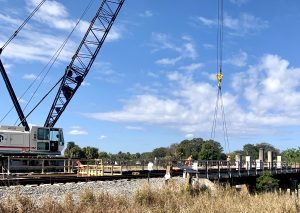
The railroad bridge over the Earman River in Palm Beach Gardens just west of Alternate A1A and north of Northlake Boulevard. (Joel Engelhardt photo)
The work calls for Brightline to rebuild 29 bridges along the FEC line, including the rail bridge over the Earman River north of Northlake Boulevard and west of Alternate A1A in Palm Beach Gardens.
The Loxahatchee River rail bridge in Jupiter also will be rebuilt.
While Brightline’s parent company no longer owns the tracks, it has taken the lead in negotiating agreements with South Florida counties for the rights to share the tracks. Grupo Mexico, a mining and rail conglomerate, paid $2.1 billion in 2017 for FEC’s 351 miles of railway.
Thank you for reading. Coming up next: Which Gardens developer has emerged from retirement to pursue a $200 million development next to the city’s proposed train station?
Joel Engelhardt wrote and edited stories at The Palm Beach Post for nearly 30 years before departing in December 2020. He has lived in Palm Beach Gardens for 28 years. He welcomes your comments and news tips at JoelOnGardens@gmail.com.

It seems like a lot of traffic will have to halt for 50 trains. What a shame I think it will cause more traffic for something thats suppose to create less. Going that speed is a scary thought. I can only hope they will have QUIET ZONES as promised. As I own 2 properties on both side of A1A.
Why would the train traffic be a problem in Gardens when that much train traffic ALREADY runs everyday in Fort Lauderdale, Miami, and West Palm Beach? South Florida is the only place in the world where I routinely see people attempt to blame mass transit for traffic problems…